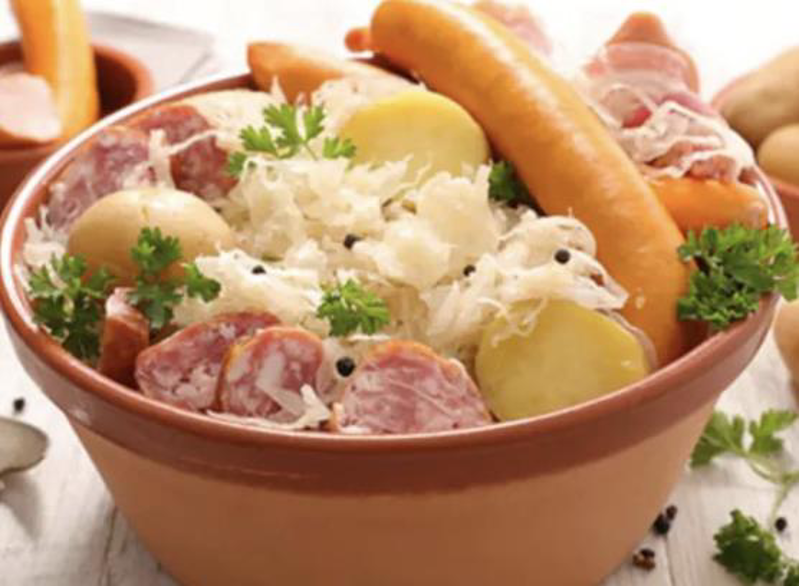Gastronomic Diary of France and Provence
Sauerkraut has a long history, believed to originate in ancient China around 2,000 years ago. It later became popular in Eastern European countries as a way to preserve cabbage during winter when fresh veggies were scarce. The name "sauerkraut" comes from German words for "sour" and "cabbage," but it's not exclusively German; it's also a French/Alsatian specialty and has Irish connections. To make sauerkraut, cabbage is shredded and layered in a container with salt. The salt draws out moisture, creating a brine that covers the cabbage. Left to ferment for weeks, the cabbage becomes sour, giving sauerkraut its distinct flavor. It's enjoyed year-round, especially in colder months, as a side dish, in hearty meals like stews and sausages, or as a lucky symbol on New Year's Day. With its tangy taste and versatility, sauerkraut remains a popular and flavorful addition to many dishes worldwide.
Ava Ingram
29 chapters
20 Jul 2023
ALSACIAN DISH
July 24, 2023
|
Steausberg (presented in class)
Sauerkraut has a long history, believed to originate in ancient China around 2,000 years ago. It later became popular in Eastern European countries as a way to preserve cabbage during winter when fresh veggies were scarce. The name "sauerkraut" comes from German words for "sour" and "cabbage," but it's not exclusively German; it's also a French/Alsatian specialty and has Irish connections. To make sauerkraut, cabbage is shredded and layered in a container with salt. The salt draws out moisture, creating a brine that covers the cabbage. Left to ferment for weeks, the cabbage becomes sour, giving sauerkraut its distinct flavor. It's enjoyed year-round, especially in colder months, as a side dish, in hearty meals like stews and sausages, or as a lucky symbol on New Year's Day. With its tangy taste and versatility, sauerkraut remains a popular and flavorful addition to many dishes worldwide.

1.
Blank Page
2.
Introduction
3.
"Terroir" : A Very French Word
4.
Focus Of My Choice (Aix-en-Provence , Based on our tour)
5.
Tips and advices: how to buy authentic and good quality wine/ olive oil/ honey
6.
Would I Advise My Friend To Go To The Market?
7.
...
8.
Chapter 1 "Provençal cuisine": #1 NOUGAT
9.
Chapter 1 "Provençal cuisine": #2 CALISSON
10.
Chapter 1 "Provençal cuisine": #3 HONEY
11.
Chapter 1 "Provençal cuisine": #4 MADELINE
12.
Chapter 1 "Provençal cuisine": #5 CHEESE
13.
Chapter 1 "Provençal cuisine" : #6 WINE
14.
Chapter 1 "Provençal cuisine": #7 FOUGASSE BREAD
15.
Chapter 1 "Provençal cuisine": RIEDERER PASTRY
16.
Chapter 1 "Provençal cuisine" Presentation: TROPEZIENNE
17.
Chapter 2 “Regional Cuisines”: MARSEILLE
18.
Chapter 2: “Regional Cuisines”: MEDITERRANEAN DIET
19.
Chapter 2 "Regional Cuisines": The Mediterranean Cultures
20.
Chapter 2 “Regional Cuisines”: TRUTH ABOUT "BOUILLABAISSE"
21.
On a trip to Strasboug... SAUERKRAUT (Choucroute)
22.
ALSACIAN DISH
23.
On a trip to Paris... CAFES
24.
PARISIAN DISH
25.
Chapter 3 Gastronomy and the "Art de vivre à la Française": NOUVELLE CUISINE
26.
"ARTS OF THE FRENCH TABLE" *from my point of view
27.
2nd Episode of Chef's Table France on Chef Alexandre Couilon:
28.
Art & French Food
29.
CONCLUSION: Lessons From French Culture
Share your travel adventures like this!
Create your own travel blog in one step
Share with friends and family to follow your journey
Easy set up, no technical knowledge needed and unlimited storage!